THE CONTEXT: Sri Lanka is going through an economic meltdown of a scale unseen since the country’s financial crisis of 1948. India also experienced a similar type of crisis in 1990, which it successfully managed. This article will undertake an economic comparison of both countries with special reference to the economic crisis.
WHAT IS THE SRI LANKAN ECONOMIC CRISIS?
The country’s crumbling economy is facing a shortage of foreign currency, which has led to a massive reduction in imports of essential items. Sri Lanka relies heavily on its imports. It imports petroleum, food, paper, sugar, lentils, medicines, and transportation equipment, among other essential items. The lack of foreign currency means the country does not have the money to buy (import) these commodities. Imports are so essential that the government had to cancel examinations for millions of school students because they ran out of printing paper. The situation in Sri Lanka is so critical that the government had to suspend operations at its only fuel refinery because it ran out of crude oil stocks. The economy is plagued by inflation, which hit 15.1 percent. Government data shows that food inflation has risen to 25.7 percent. According to the data available on IMF, Sri Lanka’s gross debt as a percentage of GDP accounted for 79.02% in 2016 and this has risen to 111.42% in 2022. This implies what the country owes is more than what it produces. The twin-deficit problem emerged. There is a continued protest going on in Sri Lanka demanding the resignation of the President and the Prime Minister.
A TIMELINE OF THE SRI LANKAN ECONOMIC CRISIS
NOVEMBER 2019:
- After winning Sri Lanka’s presidential election and months ahead of a parliamentary ballot, Gotabaya Rajapaksa announced sweeping tax cuts.
- The Cabinet cut the value-added tax to eight percent from 15 percent and also abolished seven other taxes, including a two percent nation-building tax paid by businesses.
- The sweeping tax cuts led to a credit rating downgrade in 2020, leading to Sri Lanka losing access to international financial markets.
- Sri Lanka started dipping into its foreign reserves to meet its debt obligations. This resulted in foreign reserves plummeting from a healthy level of $8,864 million in June 2019 to $2,361 million in January 2022. (See Figure 1)
2020:
- The COVID-19 pandemic in March 2020 made the situation worse. Tourist inflows and tourism revenues fell further; exports of tea and rubber declined due to lower demand; and remittances, another booster to the foreign exchange reserves, also fell as Lankans across the globe lost jobs.
- The GDP declined by 3.5 percent, the Current Account Deficit touched 7.9 percent of GDP, and the fiscal deficit climbed to 11.1 percent.
APRIL 2021:
- The Lankan government on 29 April 2021 decided to ban the import of chemical fertilizers and any other agrochemicals to make the Indian Ocean nation the first in the world to practice “organic-only” agriculture. The move was aimed at reducing pressure on forex reserves.
- Agriculture experts strongly criticized the move as “ill-advised” and “unscientific”. The farming community expressed fears that such a drastic policy shift could result in a steep drop in yield.
NOVEMBER 2021:
- Facing protests and seeing a drop in agricultural output, the government said that it would partially lift the ban.
- However, the damage was done. The ban had led to a reduction in yield, which went down by 25 percent.
- Tea cultivation, which is one of the mainstays of the economy, was also badly hit. The output of pepper, cinnamon, and vegetables went down by 30 percent.
- This forced the government to rely on rice and other staples even more from foreign countries.
MARCH 2022:
- The situation became even direr by the end of March as a critical lack of foreign currency left the island nation unable to pay for vital imports, leading to dire shortages in everything from life-saving medicines to cement.
- On 30 March, the island nation announced 13-hour daily power cuts nationwide. The country had been under severe electricity rationing since the start of the month.
APRIL 2022:
- The plunge into darkness and the severe food shortages led to people getting furious and that anger spilled onto the streets on 1 April when demonstrators tried to storm the president’s home.
- The crowd turned violent, setting two military buses, a police jeep, two patrol motorcycles, and a three-wheeler ablaze. They also threw bricks at officers. Following the violence, a 36-hour curfew was imposed.
- A state of emergency was declared, giving security forces sweeping powers.
- The crisis deepened after Sri Lanka’s Cabinet resigned en masse from their positions.
- Trading on Sri Lanka’s stock exchange is being shut down. Additionally, Sri Lanka’s central bank governor announced his resignation.
- The embattled president loses his parliamentary majority as former allies urge him to quit. He lifts the state of emergency.
- The country’s central bank hiked interest rates by a record 700 basis points in a bid to halt the free fall of the Sri Lankan rupee, which has plunged more than 35 percent in a month.
- The country announces it is defaulting on its entire external debt of $51bn as a “last resort” after running out of foreign exchange to import desperately needed goods.
SRI LANKA’S FOREIGN DEBT
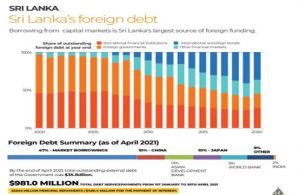
AN ANALYSIS OF THE SRI LANKAN ECONOMIC CRISIS?
Sri Lanka has suffered a serious balance of payments (BOP) crisis since early 2020. With the global spread of COVID19, Sri Lanka has lost about US $ 4 billion in annual foreign currency inflows from the tourism industry. Even before it, the Easter Day bombing had already subdued the tourist arrivals. The country’s credit rating is steadily declining due to the negative effects of COVID19 on the economy, reckless changes in economic policies such as tax cuts, and the government’s stubborn stance of not seeking support from the International Monetary Fund (IMF). Due to these developments, Sri Lanka was unable to borrow from the international capital markets through the issuance of international government bonds (ISBs). Since April 2019, this country has not issued a single ISB
Sri Lanka’s foreign exchange inflows have declined significantly. In 2020, the government imposed strict import restrictions, including the suspension of car imports, to curb the outflow of foreign currency. The outflow of foreign exchange to imports has decreased, but the obligation to repay external debt remains unchanged. This means that Sri Lanka’s external funding gap (lack of foreign currency inflows to cover foreign currency outflows) continued to widen without the opportunity to issue an ISB. In the absence of sufficient foreign exchange inflows, the government continued to deplete its foreign exchange reserves to pay off existing loans. The Sri Lankan government also tinkered with the exchange rate which led to the black marketing of this scarce resource. The usual response to this kind of serious BOP crisis is to seek the help of the IMF. In fact, the very reason the IMF was created was to help countries deal with the BOP crisis. However, the Sri Lankan government has stubbornly refused to seek the help of the IMF or restructure its debt and instead is looking to China and India. Sri Lanka also announced a default on all of its $51 billion external debt as a last resort.
HOW INDIA HAS RESPONDED TO THE SRI LANKAN ECONOMIC CRISIS?
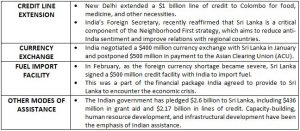
WHAT WAS INDIA’S BALANCE OF PAYMENT CRISIS?
The BOP problem began to surface in the last years of the Rajiv Gandhi administration, where fiscal expansion led to an increase in the current account deficit. Successive governments could not take decisive actions. The situation was in jeopardy when Saddam Hussein invaded Kuwait in August 1990 and oil prices soared. The market has lost confidence in the government’s ability to deal with the situation. Foreign banks stopped making new loans while claiming to repay the old ones. The influx of NRI funds has become negative. Negotiations were not very successful, as the IMF lends only to countries that are willing to make the difficult decisions needed to balance the BOP. Foreign exchange reserves were plummeting and India was at risk of defaulting. The inflation was also skyrocketing. The import cover was only sufficient to last for two weeks. The country was going through a twin-deficit crisis.
WHAT WAS INDIA’S RESPONSE TO THE CRISIS?
POLITICAL INITIATIVES:
- A Congress-led coalition under P.V. Narasimha Rao was sworn in and its first priority was to deal with the BOP crisis.
- It took strong action, including devaluation and reducing the fiscal deficit, but did not limit itself to dealing with the BOP. It also took up the other challenge of slow growth.
NEGOTIATION WITH IMF:
- The new government, with Manmohan Singh as finance minister, continued negotiations with the IMF to get loans that would tide over the immediate problem.
- The bank recommended and pushed through reforms focused on five key areas of investment and trade regimes, the financial sector, taxation, and public enterprises.
- They effectively ended four decades of central planning, significantly shifted resource allocation decisions from the public sector to the private sector and markets, and started integrating the country into the world economy.
STRUCTURAL ADJUSTMENT:
- It began with a devaluation of the rupee in two stages, on 1 July and 3 July 1991. This was accompanied by a major liberalization of trade policy.
- Almost all intermediate and capital goods, which earlier needed an import licence, were allowed to be freely imported against Exim scrips issued to exporters at 30-40% of export earnings.
- The Exim scrips were freely tradable and the premium on them was an additional incentive for exporters.
- This introduced a market mechanism for limiting imports to a sustainable level.
- Tax reforms covering both direct and indirect taxes laid out by the Chelliah committee were implemented over three years.
- Foreign capital inflows in the form of portfolio flows were liberalized in steps so is the approach toward a floating exchange rate.
A COMPARATIVE ANALYSIS BETWEEN SRI LANKAN AND INDIAN ECONOMIC CRISIS
There are many similarities between both countries with respect to the nature and causes of the crisis although they differ in their response mechanisms: Let us discuss them in detail.
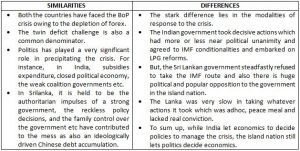
IS INDIA LIKELY TO EXPERIENCE A CRISIS SIMILAR TO THAT OF SRI LANKA?
In light of the recent Sri Lankan economic crisis, there are views that India’s debt to GDP ratio figures is in line with that of Sri Lanka and that a similar economic crisis awaits India. Sri Lanka’s total debt to GDP is certainly high, over 100%, but India’s total debt to GDP is not as high as Sri Lanka. From 2016-17 to 2020-21, India’s total public debt accounted for approximately 50% of GDP. The country’s debt position is much lower than Sri Lanka’s. But including all state debt, the debt position does not provide for a rosy picture (See Figure 2). Unlike Sri Lanka, where half of the debt is external, India’s total external debt to GDP is just under 3%, significantly lower than Sri Lanka. Also, the foreign exchange reserve totaling around $600 Billion provides a cushion to external and internal shocks.
DEBT POSITIONS OF INDIA AND SRI LANKA
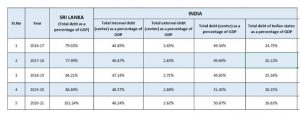
ARE THERE ANY ECONOMIC LESSONS FOR INDIA FROM THE SRI LANKAN CRISIS?
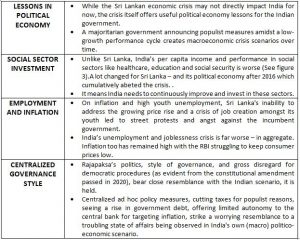
SRI LANKA AND INDIA COMPARISON
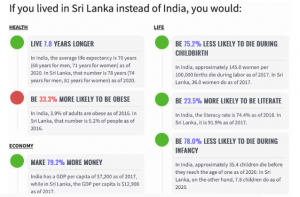
THE WAY FORWARD
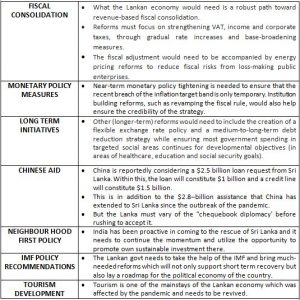
THE CONCLUSION: Sri Lanka is encountering an unprecedented economic crisis, and the country’s relations with China and India have also taken an interesting turn. So far, Sri Lanka has been trying to balance both countries and reap benefits from the geopolitical interests of China and India, as both countries have strategic interests in Sri Lanka. This was Sri Lanka’s strategy to avoid seeking IMF assistance and carry out economic reforms. However, this is a dangerous game to play for a country that is facing a severe economic crisis. In situations like these, vulnerable countries, Sri Lanka in this case, do not have much bargaining power. Thus, Lanka can learn from the Indian experience of the 1990s and it needs to approach the IMF for assistance and undertake much-needed economic reforms as India did without sacrificing national interest.
Questions:
- Critically analyze the ongoing economic crisis in Sri Lanka. What according to you can be the possible strategies to overcome it?
- “Although there are similarities between the ongoing Sri Lankan economic crisis and the Balance of Payment crisis India experienced in 1990, what differentiates them is the effectiveness of the response mechanisms of both the countries” Explain.

